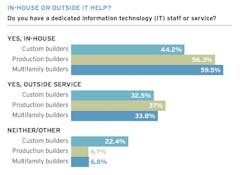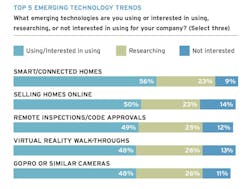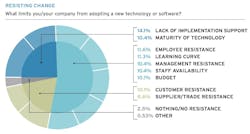Software for Home Builders: Why It Isn’t Working
Here’s a common scenario for many home builders: After spending real money to procure the latest business software (and possibly paying a monthly stipend per housing start or closing), as well as making the necessary preparations, adjustments, coding tweaks, and training staff to get everyone on board, it’s finally time to launch the new system. Oh, happy day!
The new software is clearly able to perform basic accounting functions, but the vendor says it goes way beyond that—or at least promises to. It can computerize options and selections for buyers, publish schedules, generate purchase orders (POs) and variance purchase orders (VPOs), provide site-specific 3D plans, calculate estimates and take-off quantities, track warranty work and costs to the type and visit, and communicate with customers, suppliers, and trades throughout the process.
And, at its most sophisticated, the software has the potential to take a selection chosen by the customer online, in the sales office, or in the design center, create a “digital twin” 3D model, produce the print-ready plan, analyze it for construction collisions or conflicts, instantly generate take-off quantities and pricing, then submit the contract addendum for signature. Sure, it may not perform to that level today, but the rep promises those features will be in the next update. Soon. Very Soon.
Six months later, you and your staff are having second thoughts. The software does a lot of what you believed it would when purchased, but not as much or as well as hoped. Buyer’s remorse raises its ugly little head, with some staffers openly griping about the new system. Meanwhile, your vendor is scrambling to keep up with the barrage of queries from builder customers wanting to know how to make the software perform as advertised.
Proof that Home Building Software Isn't Working: Trades Still Scout Jobsites
This situation plays itself out daily across the industry. How do we know? Because 15 to 20 times each year, my company, TrueNorth Development, conducts week-long LeanBuilding events for home builders that include an orientation session for their suppliers and trade partners.
During that session, one question we always ask trades and suppliers is how many of the builders they work with have a software-based “schedule portal” indicating where crews or deliveries should be by day, project, and lot number. Nearly all hands go up.
Next, we ask (begging for brutal honesty) how many trades and suppliers still “scout” jobsites, sending a crew leader, manager, delivery driver—maybe even the boss—to the construction site the afternoon before the crew’s arrival or the material delivery to confirm site readiness. Again, hands up all around the room.
RELATED
- (Still) Waiting for the Home Building Technology Revolution, Part I
- BIM: Pipe Dream or Promised Land?
- 3 Ways Machine Learning Can Be Useful in Construction
Let’s ponder that response ... Of the more than 1,000 supplier/trade representatives we host at that orientation each year, 900 say they scout projects. When asked why, the answer is always: “We can’t trust the information in the portal.”
We hear similar laments about programs installed to get POs and VPOs right, keep options and selections current, and provide up-to-date pricing, among other tasks builders and their partners have been told software can handle, but so far does not.
But here’s the kicker: In the majority of cases, there’s nothing whatsoever wrong with the software. These systems are perfectly capable of publishing an accurate schedule, getting take-offs correct, and nailing the POs and VPOs. Still, suppliers and trades will tell you they simply cannot trust the information coming via the builder’s software. And until they can, they’ll continue to check and confirm jobsite readiness themselves, make sure POs match the plans and specs, and chase down VPOs in limbo for months. This results in inefficiencies, duplications, and unnecessary waste ... and all of the associated costs.
Old-School Perfection Without Any Software
Over 30 years ago, I worked for a big national builder where many of its largest divisions, building as many as 1,200 units annually, ran a virtually perfect schedule—without software! It was all done by hand on big, white dry-erase boards. Walk into a construction trailer on any of the builder’s jobsites and, after looking at the board for less than a minute, you’d know exactly where the project stands, what homes are on schedule, and which ones are lagging and how badly. It was accurate, up to date, and it worked.
At this point, I know many of you are thinking, well, yeah, but what about the severe trade shortage nearly everyone has been experiencing in recent years and the COVID-induced supply chain disruptions? I’d be the last person to deny the reality of that. Yet early each Monday morning, your trades decide which builders get a crew on which day that week and where they will send their best crews. Similarly, your suppliers determine which builders receive their requested materials and in what order. Remember, somebody is going to get them. Is it you? If not, then why not? And all of the great software in the world won’t solve that problem.
Again, the software is very capable, yet it isn’t fulfilling its promise. Why? The solutions are quite easy, conceptually. There is no mystery about what is required on either the vendor side or the builder side. Implementing the answers, however, takes much greater focus and discipline than we typically find.
What Builders Say—Survey Seeks Answers About Builder Business Software Systems
This summer, Pro Builder, the University of Denver (UD), and TrueNorth Development collaborated on a survey to learn more about which business software systems builders are adopting across 16 applications, from accounting to project management, what’s working and what isn’t, and even what brands are prevalent among them.
I found the results informative but also puzzling. A passage from the sidebar article following this column really got my attention: “[T]he results tell a story of fragmentation, frustration, and a desire for software solutions designed specifically for home building operations at any scale.” Author Eric Holt, an assistant professor at UD who gathered and calculated the results, goes on to say the survey also shows “a strong willingness to implement a variety of technologies.”
He’s not kidding. Across those 16 software applications in our survey, at least 93% of builders reported using all of them (of course, not necessarily the same builders, but even so ...). Not surprisingly, nearly every builder has an accounting and job-costing app, while almost as many report using automated systems for estimating, architectural design, and scheduling—the latter perhaps helping some of those 383 builders achieve a reported frame-to-certificate of occupancy cycle time of just over three months compared with the industry average of 6 1/2 months for built-to-sell homes, according to Census data.
Less popular programs (though still used by more than 90% of those surveyed) include apps for managing sales and customer service, tracking daily jobsite trips, managing bids, and automating design and options selections. (In a separate question, builders reportedly derive 35% of revenue from options and upgrades, so it’s a critical area to manage accurately.)
To the degree you clean up your practices, processes, and systems prior to software implementation, you’ll be that much further ahead of the game.
In addition to software programs, the survey also revealed enthusiasm among builders for emerging technologies such as smart/connected homes, remote inspections, and virtual reality walk-throughs. To me, such interests reveal a higher level of sophistication than the industry at large; in my travels to various builders around the country, these technologies almost never come up in conversation.
What does come up—constantly—is getting software programs fully up to speed and supporting POs, plans, specifications, estimating, options, selections, and of course, the schedule.
Regarding what limits home building companies from adopting new software, the survey indicates it’s essentially everything, but topping the list is lack of implementation support. (Vendors, take note.) Following that, you’ll find both employee and management resistance, along with the learning curve associated with implementing new software—all of which I argue, with conviction, can be remedied by strong training strategies.
Building Software Vendor Responsibilities (and Opportunities)
On the vendor side, the greatest sources of software failure are inadequate training up-front and ongoing support long-term for builder clients. While builders answering our survey gave their vendors a 7 out of 10 rating on both counts, my one-on-ones with builders revealed less satisfaction, especially regarding continued support.
To my mind, there should be two essential training components, plus a third in some implementations. Most vendors, however, only supply the first: operator training. It goes without saying that you have to thoroughly train those who run the system daily, and here vendors are doing a generally good job, although complaints do arise.
The second element is what we call “user training,” and it’s remarkably rare to find. This isn’t training on how to operate the system, it’s training for management teams—including the most senior management—to understand how to get information from the software for smart, strategic decision-making. Managers must learn how to query the system and understand the outputs. That’s where the greatest value is, but few vendors do well in that regard and many neglect this critical element entirely.
I worked for a builder that spent eight-figure money developing its own proprietary software. The operator training was well-done, but unfortunately, the company declared the user training “optional” and thus it was implemented by just two of its 20 or so divisions.
After a year, the company killed the proprietary system, despite its massive investment, and started fresh with an outside, big-name vendor—with an even larger eight-figure price tag. Why? The builder’s field staff were unhappy with the internally developed software. Well, not all of them. The two divisions that attended the user training thought the software was great and used it daily, telling anyone who would listen, but few did. It was the user training that made all of the difference.
The problem is not the software itself, but the training and implementation at the outset, and then the ongoing support of the system by both the vendor and the builder.
In my experience on the front lines, the level of user training for software systems implemented by builders today is, in most cases, either minimal or nonexistent. This is as big a cause of failure as poor operator training. Finally, for any software requiring supplier/trade interfacing, the training for them must be just as good—and mandatory.
The final cause of failure we see is lack of ongoing support. I’ve been asked by three separate builders this year, each using a different software vendor, if I know someone I could personally appeal to on the vendor’s management team to put some real effort into solving a builder’s particular software problem because the vendor’s field rep can’t get the job done. Here at TrueNorth we constantly hear complaints from builders that ongoing software support is too slow and otherwise insufficient, and the laments cover a wide spectrum of vendors.
It’s clear: Training and ongoing support are true areas of opportunity where a vendor can really build a competitive advantage.
The Builder's Role in Software Success: Daily Discipline
So, what about builders’ failures in this equation? It’s something amazingly simple, yet evidently incredibly hard to do. That is, all databases must be kept current every day. This discipline is critical for the schedule, obviously, but also for quantities, pricing, plan changes, specification changes, options and selections, and so on. Anything less results in workarounds internally, in the field, and among your suppliers and trades. It’s a matter of “garbage in, garbage out,” and the consequence is no one trusts the software system—when the output is garbage.
I tell vendors that unless a builder swears on everything they hold dear that they’ll update the database every day, just refuse to sell the builder your software and save yourself the hassle (and reputational risk) of your program “failing” a builder client! If the database is not updated daily, the software will fail to be relevant, and that’s no fault of the vendor. This is so obvious, so necessary, yet so few builders meet this standard, and still they hold the vendor accountable.
Yes, both software vendors and home builders are equally guilty in response to the question, “Why isn’t the software working?” You can’t digitize, computerize, or otherwise automate a bad system. To the degree you clean up your practices, processes, and systems prior to software implementation, you’ll be that much further ahead of the game.
RELATED
- Business Measurement Fails, Part I
- Tech Tools for Builders: Mobile Apps
- Jason Adams on How Connecting Data to the Cloud Rained Actionable Insights
There are a ton of great software options available, most not yet fully meeting home builders’ considerable expectations. The problem is not the software itself but the training and implementation at the outset, and then the ongoing support of the system by both the vendor and the builder.
Despite the fact our survey revealed just 12% of builders claim their business software programs are “completely” integrated, the promise of a massively capable, fully integrated software system is so compelling, our industry will never abandon that goal. Which brings up a final point for vendors: “Don’t say the ‘I’ word,” meaning, don’t say your system is fully integrated—until all of your builder customers agree. I’m still waiting to hear that universal decree. The issues won’t be solved until both sides take a more disciplined approach, each fully committing to doing their part, as described above.
It’s going to happen. It has to happen. And those who get there first will reap immeasurable rewards in productivity and efficiency, two things every builder needs today.
Builders and Business Technology: Benchmark Your Experience
By Eric A. Holt, Ph.D.
Believe it or not, there are more than 300 computer software programs targeting the construction and home building sector. So how does a home builder choose the best software solution to help run the business and get homes built?
This summer, in collaboration with Pro Builder and TrueNorth Development, the University of Denver surveyed home builders to learn what software they’re using, from accounting and estimating to scheduling, customer relations, and design.
From 383 qualified responses, the results tell a story of fragmentation, frustration, and a desire for software solutions designed specifically for home building operations at any scale ... but also a strong willingness to implement a variety of technologies.
The results allow home builders to benchmark their use of business software and their interest in and implementation of other housing technologies against their peers, including the following telling insights:
- Builders use either in-house or external information technology (IT) services to help manage their software.
- The top three technology trends are smart/connected homes, selling homes online, and conducting remote inspections.
- Resistance to implementing new software programs centers on lack of implementation support from technology providers, followed by employee resistance and the learning curve required to implement a new program.
You can find additional insights from the 2022 Builders and Business Technology Survey below.
Methodology: In collaboration with TrueNorth Development and the University of Denver, the 2022 “Builders and Business Technology Survey” was distributed to home builders among Pro Builder’s print and digital audiences between June 20 and July 7, 2022, returning 383 completed surveys. Recipients were offered the chance to win one of four $100 Visa gift cards for completing the online survey. Gift cards were awarded in November 2022.
Eric A. Holt, Ph.D., is an assistant professor in the Franklin L. Burns School of Real Estate and Construction Management, Daniels College of Business at the University of Denver.




